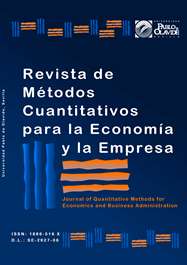El impacto económico del desmantelamiento nuclear en España
DOI:
https://doi.org/10.46661/revmetodoscuanteconempresa.2748Palabras clave:
desmantelamiento nuclear, impacto económico, modelo input-output, nuclear dismantling, economic impact, input-output modelResumen
El proceso de desmantelamiento de una central nuclear conlleva una serie de actividades económicas, vinculadas a sectores económicos distintos del energético, que suponen una oportunidad de desarrollo económico, no solo para las comunidades locales en las que se emplaza la central, sino también para el resto de la sociedad. Actualmente, las centrales nucleares españolas tienen una vida operativa media de 33 años y en una década acabará su vida de diseño, por lo que es de interés conocer la repercusión económica que tendrá su desmantelamiento. Para ello, en el presente artículo, se desarrolla un modelo multisectorial con el que se analiza el impacto del proceso de desmantelamiento, que engloba tanto el cierre de las centrales, como la sustitución por otras fuentes energéticas y la gestión de los residuos radioactivos.
Descargas
Citas
Bacharach, M. (1970). Biproportional Matrices & Input-Output Change, University of Cambridge Department of Applied Economics Monographs.
Bretschger, L., & Zhang, L. (2017). Nuclear Phase-out Under Stringent Climate Policies: A Dynamic Macroeconomic Analysis. Energy Journal, 38(1).
Barcelo Vernet, J. (2003). Social and economic aspects of the decommissioning of nuclear installations. In Safe Decommissioning for Nuclear Activities (Proc. Int. Conf. Berlin, 2002), IAEA, Vienna (pp. 403-410).
Bond, A., Bussell, M., O'Sullivan, P., & Palerm, J. (2003). Environmental impact assessment and the decommissioning of nuclear power plants—a review and suggestion for a best practicable approach. Environmental Impact Assessment Review, 23(2), 197-217.
Bond, A., Palerm, J., & Haigh, P. (2004). Public participation in EIA of nuclear power plant decommissioning projects: a case study analysis. Environmental Impact Assessment Review, 24(6), 617-641.
Consejo de Seguridad Nuclear (2017). Informe del Consejo de Seguridad Nuclear al Congreso de los Diputados y al Senado, 2016.
ENRESA (2007). Memoria del desmantelamiento 1998-2003, Central Vandellós I.
ENRESA (2015). Memoria del desmantelamiento de la CN José Cabrera 2010-2014.
European Parliament – Directorate General for Internal Policies – Policy Department Budgetary
Affairs (2013). Nuclear Decommissioning: Management of Costs and Risks.
Fuentes-Saguar, P. D., Vega-Cervera, J. A., & Cardenete, M. A. (2017). Socio-economic impact of a nuclear power plant: Almaraz (Spain). Applied Economics, 1-11.
Grangeston (2012). The Socio-economic Impacts of Dounreay Decommissioning. Highlands and Islands Enterprise and Dounreay Site Restoration Ltd.
Greenpeace (2016). El impacto económico del desmantelamiento nuclear en España.
Haller, M. (2014). The socio-economic effects of decommissioning on local communities: A media framing analysis of the experience of Wiscasset, Maine. Middle States Geographer, 47, 48-59.
House of Commons – Committee of Public Accounts (2013). Nuclear Decommissioning Authority: Managing Risk at Sellafield, Twenty-Fourth Report of Session 2012-13.
IAEA (2008). Managing the Socioeconomic Impact of the Decommissioning of Nuclear Facilities, Technical Report Series, 464.
IDAE (2011). Evolución tecnológica y prospectiva de costes de las energías renovables. Estudio técnico PER 2011-2020, Instituto para la Diversificación y Ahorro de la Energía. Ministerio de Industria, Energía y Turismo.
LaGuardia, T. S. (2012). Financing and Economics of Nuclear Facility Decommissioning, capítulo 4 en Michele Laraia (Ed.), Nuclear Decommissioning: Planning, Execution and International Experience, Elsevier.
Lahr, M. L., & Dietzenbacher, E. (Eds.). (2001). Input-output analysis: Frontiers and extensions. Palgrave.
Llop, M., & Sardà, J. (2005). Impacto económico del desmantelamiento de la central nuclear Vandellós I. Enresa Publicación técnica 08/2005.
McCullough et al (2013). Economic Analysis of the Columbia Generating Station, Mc Cullough Research.
Miller, R. E., & Blair, P. D. (2009). Input-output analysis: foundations and extensions. Cambridge University Press.
MINETUR (2015). Informe de sostenibilidad ambiental de la planificación del Sector eléctrico 2015-2020.
Mullin, J. R. & Kotval, Z (1997). The closing of the Yankee Rowe nuclear power plant: The impact on a New England community. Journal of the American Planning Association, 63(4), 454-468.
Red Eléctrica de España (2016). Informe del Sistema Eléctrico Español 2015.
Riener, K. D. (2010). The Local Economic Impacts of Decommissioning the Diablo Canyon Power Plant. California Public Utilities Commission and Pacific Gas and Electric Company.
Robles, L., & Sanjuán, J. (2005). Análisis comparativo de las tablas input-output en el tiempo. Estadística Española, 47(158), 143-177.
Seier, M., & Zimmermann, T. (2014). Environmental impacts of decommissioning nuclear power plants: methodical challenges, case study, and implications. The International Journal of Life Cycle Assessment, 19(12), 1919-1932.
Wallbridge, S., Banford, A., & Azapagic, A. (2013). Life cycle environmental impacts of decommissioning Magnox nuclear power plants in the UK. The International Journal of Life Cycle Assessment, 18(5), 990-1008.
Descargas
Publicado
Cómo citar
Número
Sección
Licencia
Derechos de autor 2018 Revista de Métodos Cuantitativos para la Economía y la Empresa

Esta obra está bajo una licencia internacional Creative Commons Atribución-CompartirIgual 4.0.
El envío de un manuscrito a la Revista supone que el trabajo no ha sido publicado anteriormente (excepto en la forma de un abstract o como parte de una tesis), que no está bajo consideración para su publicación en ninguna otra revista o editorial y que, en caso de aceptación, los autores están conforme con la transferencia automática del copyright a la Revista para su publicación y difusión. Los autores retendrán los derechos de autor para usar y compartir su artículo con un uso personal, institucional o con fines docentes; igualmente retiene los derechos de patente, de marca registrada (en caso de que sean aplicables) o derechos morales de autor (incluyendo los datos de investigación).
Los artículos publicados en la Revista están sujetos a la licencia Creative Commons CC-BY-SA de tipo Reconocimiento-CompartirIgual. Se permite el uso comercial de la obra, reconociendo su autoría, y de las posibles obras derivadas, la distribución de las cuales se debe hacer con una licencia igual a la que regula la obra original.
Hasta el volumen 21 se ha estado empleando la versión de licencia CC-BY-SA 3.0 ES y se ha comenzado a usar la versión CC-BY-SA 4.0 desde el volumen 22.










